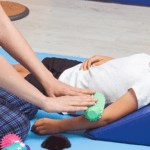It is estimated that Attention-Deficit Hyperactivity Disorder (ADHD) affects three to five percent of all preschool and school-aged children. Yet the role nutrition plays in managing a child’s ADHD symptoms is not as cut and dry as you might think. Even more surprising is the role physical therapy plays in ways children with ADHD perform in school and other situations where they have to pay attention for long periods of time. Call Sensational Kidz Therapy today to find out how our physical therapist can help your child manage their symptoms.
Nutrition and ADHD
Every parent of a child with ADHD would love to think there is a magic formula for making their child’s attention or hyperactivity problems go away. For many people, the assumption is that there is something in their child’s diet that is causing their symptoms. They may eliminate sugar, food dye or even wheat from their child’s diet in an effort to control their symptoms. However, medical research does not necessarily support the link between any one food item and ADHD. Other parents feel that their child’s diet is lacking one or more vitamins that may be causing attention or hyperactivity problems. They may even go so far as to give their child supplements to “make up the difference” in their nutrition, but medical research does not support this link either.
Feeding a Developing Brain
What research does support is the link between a healthy, balanced diet and the ability to perform daily tasks. For instance, research supports the link between eating a healthy, well-balanced breakfast and a person’s ability to do complex tasks. The same research shows that eating rapidly digesting carbohydrates, fast food, saturated and trans fats and processed foods has a negative impact on a person’s ability to think, pay attention and reason. However, these recommendations are for all people, not just children with ADHD. We should all eat a lot of fresh fruits and vegetables, some whole grains and adequate amounts of proteins and unsaturated fats.
Physical Therapy and ADHD
Even though there is no magic diet for your child’s ADHD symptoms, that doesn’t mean you don’t have a way to help them pay attention. Motor problems happen in 30-50 percent of all children with ADHD. However, these problems with strength, balance and mobility are rarely addressed in children because so much emphasis is placed on the emotional and social problems associated with the condition. Still, using physical therapy to help a child have better balance, movement and mobility can relieve many problems we perceive as ADHD. For instance, a child who has problems with balance may be constantly shifting in their seat to send signals to their brain that they are still upright. Addressing the balance issues may also address what we perceive as hyperactivity.
Fortunately, a physical therapist is an expert in movement. Not only can they identify potential problems with your child’s motor skills, they can develop a physical therapy plan to address them. Unlike physical therapy after surgery or for an injury, physical therapy for a child with ADHD may look a lot like playing games. A physical therapist will use play to help your child gain the skills they need to be able to sit upright in a chair, have better balance and move appropriately.
Even though there is no magic diet that will magically make your child’s ADHD symptoms go away, supporting their developing brain with proper nutrition can set them up for success. However, adding physical therapy to their treatment plan can help address underlying motor problems that may be causing some of their symptoms.
Contact Sensational Kidz Therapy today to see if physical therapy is right for your child.







Leave a Reply